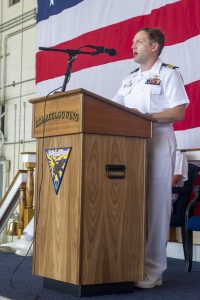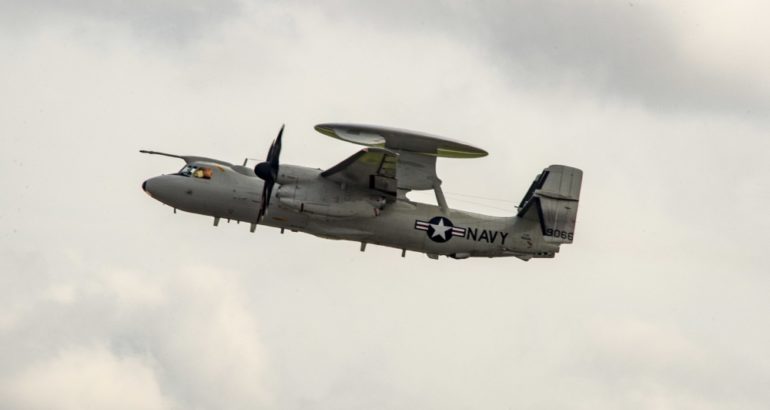By Robbin Laird
Recently I had a chance to discuss with the CO of VAW 121 about the way ahead with coming of air refuelability for the squadron’s Advanced Hawkeyes. I was able to do so after CDR Neil Fletcher had spent a good part of his early day on October 21, 2020 talking with reporters about the anniversary of the first launch of the Hawkeye.
That 60th Anniversary of the first E-2 flight was highlighted in a discussion between the Commander of the Naval Air Force Atlantic, Rear Admiral Meir and the current Commander of the Airborne Command and Control Logistics Wing, Captain Michael France.
The discussion with CDR Fletcher provided further insights as well.
The advanced Hawkeye has joined the fleet as the fleet is undergoing significant change to focus on the high-end fight, and to deliver capabilities to an evolving process of integratability.
With the extended range air refueling brings to the Advanced Hawkeye plus the coming of the MQ-25 to the large deck carrier to do that air-refueling mission, the contribution of the aircraft will be enhanced for the fleet operating in the extended battlespace.
CDR Fletcher highlighted the importance of this new capability for the aircraft. “We should receive our first AR aircraft shortly. We will be the second squadron to complete the AR transition. By next year we will be fully transitioned as an AR squadron.
“This will give us more time on station and increase our range. We have always been focused on the carrier strike group, but throughout my career we have also supported the joint fight,so this capability will enhance our contribution.”
“We’ve always been an integratable asset, but AR will make us just that much more capable as we extend our on station time.”

With the new advanced Hawkeye there is more capability in the aircraft to integrate with the mission.
He noted that even though the aircraft looks much like its predecessor, “the advancements in technology with the digital generation, allows us to pack a lot more capability within the aircraft and also allows us to work differently in the battlespace.”
There has been an important branding change which reflects the shift as well. They are now an airborne command and control squadron, rather than being labelled an airborne early warning squadron.
As CDR Fletcher put it: “That branding change is purposeful; it is an evolution incorporating technological advances which enable us to be more interconnected, and more integratable.
“Much like we are more interconnected through the internet, which has changed all of our lives, its doing the same for naval aviation and the military.”
One can accept the evolution point, but integratability is posing a significant shift as well.
Certainly, for the weapons officers in the back of the aircraft, the challenge now is to manage a much wider range of data sources to shape C2 information flows as well.
As the U.S. Navy evolves its concepts of operations to distributed maritime operations, certainly the capabilities in AR advanced Hawkeye will become even more important for the air wing of the future, or as I prefer to call it, the integratable air wing.
The featured photo:
NORFOLK, Va. (Septeember 9, 2019) – An E-2D Hawkeye prepares to land and be received by the Greyhawks of Carrier Airborne Early Warning Squadron (VAW) 120 on Monday, September 9 at Naval Station Norfolk. This is the first E-2D Hawkeye with aerial refueling capability to join the fleet, increasing the Navy™s battlespace awareness and integrated fire control ” both from the air and the sea. (U.S. Navy Photo by Mass Communication Specialist 3rd Class Nikita Custer)
Also, see the following:
Shaping A Way Ahead for the Hawkeye/ Stingray Cluster in the Integratable Carrier Air Wing
60th Anniversary of First E-2 Flight: Looking Back and Shaping a Way Ahead


